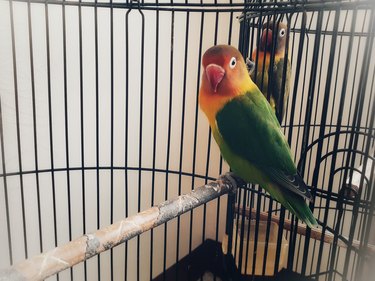Although there are over 115 parakeet species, most people equate parakeets with budgerigars, or budgies — the small, slender birds with long tails commonly found in pet stores. The easiest and quickest way to sex these parakeets is to look at the color of their cere, the band of skin above the bill. Male adult budgies have blue or purplish ceres, while females' ceres are tan or brownish. Other parakeet species do not share these characteristics.

Video of the Day
Most common parakeet species
Parakeets are small, seed-eating parrots with slender bodies and long, tapering tails. Budgerigars, or budgies, are the most common caged pet birds and the ones most often identified with the parakeet species. The most common color is green or greenish-yellow, but they can also be yellow, blue, purple, gray, white, and combinations of colors. You won't find black pet birds among parakeets, although budgies usually have black barring on their head, and other parakeets have black rings on their neck or black-tipped wings.
Video of the Day
English budgies have fuller faces with more feathering than the American budgies found in most United States pet stores. American budgies are quite a bit smaller than English budgies as well. However, these two types of budgies share the same physical characteristics that help identify males and females.
Although "perico" means parakeet in Spanish, perico birds are a different species. Native to Mexico and South America, some have migrated to southern Texas too. Probably called parakeets because of their small size, they are also called Mexican green parakeets, so it can be confusing because many budgies are green as well. Conures are also popular parakeet pets, but they do not share the budgie's characteristics for telling one sex from another.
Cere, legs, and feet reveal sex
The easiest way to tell males from females, which is called sexing, is to examine the color of their cere, the band of skin surrounding the nostrils. In male budgies, the cere is usually blue, while a female's cere is tan or brown, often with white circles around the nostrils.
During mating season, the male's cere turns a deeper blue or almost purple, while the female's cere becomes enlarged and crusty. In adults, bluish skin on their legs and feet indicates a male, while females have tan or rose skin. Be sure your budgie is old enough to use leg color since a baby's skin and cere will change color during the first year of life.
Exceptions to color rules
Although the color of the cere is a reliable way to identify a budgie's gender, there are several exceptions. When her hormone levels are low or she is ill, a female's cere may be light blue, and the male's may be brown or brownish-pink with a yellowish-green tinge around the nostrils. Newborn budgies are another exception; both sexes are pink all over with pink ceres. After the first few weeks, their ceres will begin to change color, though it isn't necessarily a fixed color until they are 1 year old.
There are other exceptions:
- Albino budgies have no coloring, so their cere, legs, and feet will be pink.
- Budgies with specially bred colors cannot be reliably sexed male or female.
- Cinnamon budgies have pink ceres in both sexes.
While you won't be able to tell the sex of these budgies in their first year, you may when they become sexually mature. During the mating season, if your budgie's cere seems to swell and becomes crusty, you have a female. If it doesn't, you most likely have a male budgie. Specially bred pied budgies may have mottled ceres when they are young, but after a year, they should have a set color.
Behavior can be a clue
Just as with humans, it cannot always be said that males behave one way while females behave another. Generally, however, male budgies are more likely to sing than squawk, and males bob their heads as if keeping time to a beat. Females are often more aggressive and territorial. You should be able to coax a male budgie onto your finger, while a female may resist the overture and may even bite the finger instead. If your budgie learns to talk, he is most likely a male.
Sexing other types of parakeets
The methods of sexing budgies cannot be used reliably to sex other parakeet species. Many do not have the budgie cere, and others, like blossom-headed and Alexandrine parakeets, are not very vocal by nature, so you can't tell a male from a female by singing or vocalizing. Each parakeet species has different ways of telling male from female, like the male rosy Bourke parakeet's salmon-colored throat, but for some, it is impossible to tell unless one lays eggs or undergoes a DNA test.
- PetBudgie.com: Sexing Your Mature Budgies
- Animal Food Planet: 3 Foolproof Methods How to Tell the Budgie Gender
- PetKeen: 27 Parakeet Colors, Types, Varieties & Patterns (With Pictures)
- Omlet: How to Tell Parakeet Sexes Apart
- Britannica: Parakeet
- Audubon: Green Parakeet
- Budgieplace.com: Your Budgie’s Sex